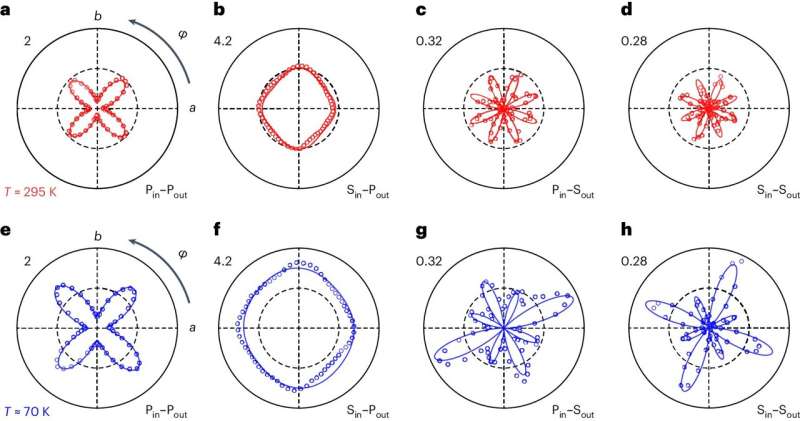"Research Reveals Broken Mirror Symmetry in Fermi-Liquid-Like Phase of Cuprate"

August 27, 2024 feature
This article has been reviewed according to Science X's editorial process and policies. Editors have highlighted the following attributes while ensuring the content's credibility:
- fact-checked
- peer-reviewed publication
- trusted source
- proofread
by Ingrid Fadelli , Phys.org
Materials that exhibit superconducting properties at high temperatures, known as high-temperature superconductors, have been the focus of numerous recent studies, as they can be used to develop new technologies that perform well at higher temperatures. Although high-temperature superconductivity has been widely investigated, its underlying physics is not yet fully understood.
One key step toward a better understanding of high-temperature superconductivity is to identify ordered phases of high-temperature superconductors and their underlying symmetries. This is because phase transitions in these materials may ultimately be linked to their superconductivity.
Researchers at Seoul National University in Korea recently carried out a study exploring phases and related symmetries in the cuprate material (Bi,Pb)2Sr2CaCu2O8+δ. Their findings, published in Nature Physics, unveiled a Fermi-liquid-like phase occurring in this material beyond critical doping, characterized by a broken mirror symmetry.
'About four years ago, we were looking for a suitable experiment for our new equipment called rotational anisotropy second harmonic generation (RA-SHG) which is a very sensitive technique and has become an important experimental tool,' Changyoung Kim, co-author of the paper, told Phys.org.
'There were a couple of suggestions that there could be a new phase in a region of the copper oxide or cuprate superconductor phase diagram, called the over-doped region. Instinct kicked in and we realized SHG is a suitable tool to look for such phases.'
The superconductivity in cuprate superconductors can be modulated using a technique known as doping, which entails adding impurities or other elements to a material to change its properties.
This process allows researchers to selectively attain superconductors, metals or insulators. The doping amount at which superconductivity can be obtained at the highest temperature is around a value of 0.15, while anything above this value is considered 'over-doping.'
Recent studies showed that over-doped cuprate superconductors could exhibit a new phase. Kim and his colleagues set out to probe this phase using lead-doped superconductors previously synthesized in their laboratories.
'Symmetries tell us a lot about nature,' Kim explained. 'Therefore, figuring out symmetries is an important step in physics research. However, sometimes symmetries can be subtle (or sometimes hidden) and thus identifying symmetries (or broken symmetries) can become quite difficult. SHG is a technique that allows us to detect symmetries or their breaking in the most sensitive way.'
Using the RA-SHG developed at their lab, the researchers performed a series of tests on (Bi,Pb)2Sr2CaCu2O8+δ samples that had been doped beyond critical doping. Critical doping is a state in which the concentration of dopants introduced in a material exceeds a specific threshold, after which the material will present different physical properties.
'In physics, there is something called quantum phase transition, a phase transition that occurs at zero Kelvin (absolute zero temperature),' Kim explained. 'The point at which the phase transition occurs at 0 K is called a quantum critical point. It is believed that the high temperature superconductivity is related to this quantum critical point.
'In the case of cuprate superconductors, the critical doping is about 0.19 and our experiments were performed on samples that exceeded this value.'
The researchers uncovered a broken mirror symmetry in their cuprate sample, specifically in a Fermi-liquid-like phase that occurred beyond critical doping. The temperature at which this phase was observed coincided with the temperature at which strange metals typically transition into Fermi-liquid-like metals.
'Symmetries bare important information and it is expected that this information can lead us to the microscopic mechanism of the high temperature superconductivity,' Kim said. 'This is why identifying phases and their symmetries has been at the heart of the cuprate superconductor research.
'In our work, we found a new phase and its symmetry in the phase diagram. The symmetry of the new phase can help us identify the phase, which in turn can provide us with more information about how an electron interacts with other electrons or its surroundings.'
The new phase uncovered as part of this recent study could soon be further examined using various other experimental techniques. Kim and his colleagues hope that both their recent and future studies will contribute to the understanding of high temperature superconductivity.
'Even though our work strongly suggests that there is a new phase, it is also important to double check with other experimental techniques,' added Kim. 'Experiments with other techniques are in progress. In particular, we are hoping to identify the new phase (SHG tells us the kind of symmetries the new phase has but not what it is). We are also planning to pursue theoretical investigation in collaboration with a theory group.'
More information: Saegyeol Jung et al, Spontaneous breaking of mirror symmetry in a cuprate beyond critical doping, Nature Physics (2024). DOI: 10.1038/s41567-024-02601-1
Alessandra Milloch et al, New order in the copper oxide phase diagram, Nature Physics (2024). DOI: 10.1038/s41567-024-02602-0
Journal information: Nature Physics
© 2024 Science X Network




